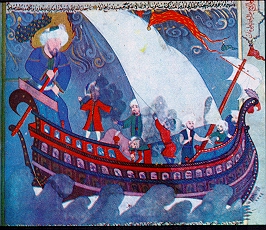Prior to the
Turkish revolution in 1924, the Palace was the home to a community
that provided all services necessary to everyday court life and
ceremonial events: from mosques, schools, baths, workshops,
studios, and libraries to the armory, mint, and treasury where the
most precious objects were kept. Today this vast collection of
riches and relics, together with the buildings within Topkapi's
labyrinthine structure, attracts visitors and scholars from all
over the world.
The following items represent
museum's outstanding group of Islamic miniature paintings, found
in illustrated copies of classic works and as surviving fragments
pasted or bound into albums in the former royal libraries. The
first examples of the Ottoman miniature paintings were produced
under the patronage of Fatih Sultan Mehmet (Mehmet the Conqueror )
in mid 15th century. An important feature of the Ottoman
miniatures is the realistic portrayal of actual events while
adhering to the traditional rules of Islamic art. Topkapi's
priceless collection encompasses not only Ottoman works but also
those of many different dynasties and regions within the Islamic
world, including Baghdad and Mosul in Mesopotamia (13th century);
Il-Khanid Tabriz and Muzaffarid Shiraz (14th century); and
Akkoyunlu Shiraz and Tabriz, Timurid Herat, and Safavid Shiraz and
Tabriz (15th century). Included are scientific works such as
Dioscorides' Materia Medica; romances such as the fables
of Khalila and Dimna; the
Khamsa of Nizami, the Shahname of Firdawsi; and later
Ottoman works such as the Süleymanname and the Selimname,
in praise of the exploits of individual sultans.
Early Islamic Illustrations
Secular illustrations and Persian
Painting
Mongols and Painting under the
Jala'ir
Painting in Persia under the
Timurids
China, chinoiserie and Painting in
Turkestan under the Timurids
The Uzbeks and the Safavids
Book Illustration under the
Ottomans
Turkish Miniatures in the 16th
Century - Ministary of foreign affairs
Turkish -Islamic Art, The
Miniatures of the Zubdat Al- Tawarikh

The
topkapi scroll: geometry and ornament in Islamic architecture.